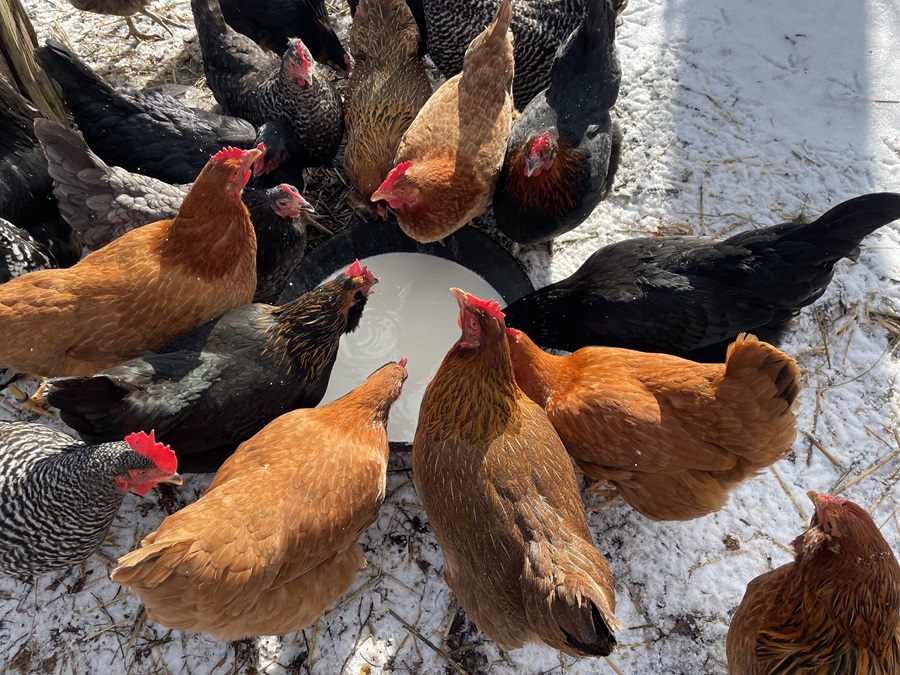Like rosebuds, like leaves, like most living things, in the absence of sunlight, hens’ eggs do not bloom.
In the depths of winter, a farm-fresh egg seems like the perfect boost — its tender yolk, bright and yellow and robust with protein, an antidote to steely skies. It’s not so easy to find one in the waning light of December, though.
Chickens naturally molt as the days grow shorter in the fall, using protein to renew their feathers for good winter insulation rather than to generate eggs. Following that, as the hours of sunlight dwindle each day, so too does their egg production.

By this time of year, you’ll begin to have better luck finding your fix from a backyard farmer. In February, with roughly 10 and a half hours of sunlight each day (and daylight hours noticeably on the upswing), hens begin to lay a few eggs.
This is the case for Paula Erickson’s chickens, who cease production as winter sets in. At her place in Truro, the hens began to lay again in January.
“Instead of an egg a day, which is what they do in the best of circumstances, they might give an egg every other day,” Erickson says of her 15 hens at this time of year.
Chicken keepers have found a way to circumvent the winter hiatus by putting artificial light in the coop — a kind of avian seasonal affective disorder lamp, if you will. Victoria Pecoraro, who has raised hens at her Wellfleet Chick Koop & Farm for 25 years, “lights up” her chickens.
Pecoraro says her system is simple. She connects a sturdy waterproof extension cord to an external outlet on her house and hooks up her coop’s lights to a timer so they go on an hour before dark and shut off around 9 p.m., she says.
There are a few risks with using artificial lights, according to Storey’s Guide to Raising Chickens. For one, you might forget to turn the lights on one day. This could induce the chickens to molt and stop laying for months. On the other hand, if you leave the lights on around the clock, it will deprive the hens of the 6 to 8 hours of darkness needed to maintain their immune systems — what Erickson calls “nature’s cycle.”
Storey’s also warns against fluorescent lights, recommending incandescent bulbs instead, which the book says are easier to adjust and install. We all know, however, that incandescents are less energy efficient, so, if you must, buy those warm-hued fluorescents because cool tones will not work.
There are countless factors that could alter seasonal productivity beyond the question of sunlight, says Pecoraro. The time of year that pullets are purchased and the breed and variety of the hens can affect their sensitivity to light and therefore their egg output.
For Pecoraro, keeping hens that lay at different paces is not so much a science as it is instinctual: she keeps some in her flock that aren’t so efficient because “maybe they’re really pretty and nice birds,” she says.
While most backyard hens live six to eight years, they lay fewer eggs as they get older. The younger the chicken, Erickson says, the more likely it will produce eggs with fewer hours of sunlight — they’ve got the hormone levels to do it.
Erickson points out that chickens have a finite number of eggs they will produce in a lifetime, just as humans do. As a farmer, “you could speed that up, or you could let that play out, but you’re only going to get the same number of eggs.” That number varies widely depending on the species, but United Egg Producers says that it is roughly 300 eggs per year.
Pecoraro typically purchases pullets at the end of October with the hope that they will begin laying in early spring. That way, she can have her dozens of chickens lay the maximum number of eggs to sell by the high season. Right now, she’s putting her eggs in her winter Community Supported Agriculture box.
If the only thing that can pull you out of your winter funk is a sunny-yolked egg, there’s hope. A number of farm stands across the Outer Cape are starting to sell fresh eggs now. Keep your eyes peeled for a sign on the roadside, and you will soon find yourself a first taste of spring.



